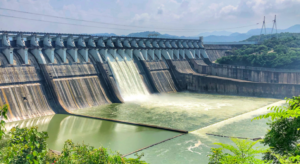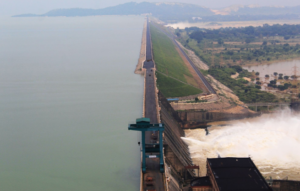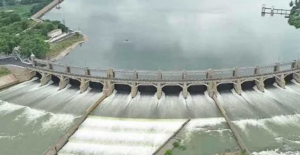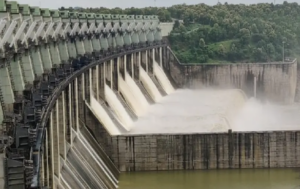Table of Contents
India has many large and deep rivers, like the Ganga, Brahmaputra, and Narmada. Water is important for all life, making storage important. Dams in India are for sustainable development and resource management. As one of the world’s most populous countries, India faces challenges in meeting growing energy needs and managing water for agriculture and industry. Dams help by storing water and generating hydroelectric power. That is why the Indian government is focused on building dams to prevent floods, generate power, and supply water when needed. This article will explore the major dams in India.
What is a Dam?
A dam is a structure that blocks or controls water flow, creating reservoirs for flood control, irrigation, drinking water, industry, and navigation. Dams can also generate hydropower for electricity. They store and supply water to different areas, ensuring fair access for farming, especially in places where crops like sugarcane and rice require a lot of water.
However, building large dams causes problems:
- Social issues like displacing many people without proper rehabilitation.
- Economic concerns due to high costs without proportional benefits.
- Environmental problems, including deforestation and loss of biodiversity.
Types of Dams in India
A dam is a barrier that controls water flow, helps prevent floods, and provides water for irrigation, industry, and aquaculture. Here are seven types of dams used in America:
- Diversion Dam: Diverts water into canals or ditches. These are usually small, with a low height and limited storage.
- Buttress Dam: A sloping deck supported by buttresses. It uses less concrete but can be more expensive.
- Embankment Dam: Made from natural materials like soil, sand, and rock. It’s a large, artificial dam built with compacted materials.
- Cofferdam: A temporary, portable dam used for construction projects like bridge repairs and pipeline installation. It’s reusable and eco-friendly.
- Storage Dam: Designed to store water for irrigation, wildlife, and hydroelectric power. These are the most common type of dam.
- Detention Dam: Built for flood control, it holds water temporarily and releases it gradually to reduce flash floods.
- Gravity Dam: A massive concrete dam that holds large volumes of water. It relies on gravity and a strong foundation to resist water pressure.
List of Major Dams in India:
Nagarjuna Sagar Dam (Andhra Pradesh): Built on the Krishna River in 1967, it is one of the largest dams in India, crucial for irrigation, power generation, and flood control.

Sardar Sarovar Dam (Gujarat): Located on the Narmada River, it provides water for irrigation and drinking. It has been controversial due to its impact on displaced communities.

Bhakra Dam (Himachal Pradesh): Built on the Sutlej River, it is one of the highest gravity dams, providing irrigation and hydroelectric power.

Idukki Dam (Kerala): A double-curvature arch dam in the Western Ghats, it plays a key role in hydroelectric power generation and irrigation.

Tehri Dam (Uttarakhand): On the Bhagirathi River, it is one of the tallest dams in India, providing water, power, and serving as a reservoir for drinking water.

Hirakud Dam (Odisha): Built on the Mahanadi River, it is the longest earthen dam in the world, important for flood control, irrigation, and power generation.

Koyna Dam (Maharashtra): Built on the Koyna River, it is a major hydroelectric project, contributing significantly to Maharashtra’s power supply.

Mettur Dam (Tamil Nadu): On the Cauvery River, it provides irrigation to Tamil Nadu’s delta region, supplies drinking water, and generates hydroelectric power.

Rihand Dam (Uttar Pradesh): Built on the Rihand River, it is the largest dam in Uttar Pradesh, providing water for irrigation, power generation, and regulating water flow.

Indira Sagar Dam (Madhya Pradesh): Located on the Narmada River, it is one of the largest reservoirs, supporting irrigation, power generation, and drinking water supply.

These dams are essential for irrigation, power, flood control, and water storage, playing a major role in the development of their regions.
State-wise list of Major Dams in India
Checkout the state-wise list of Major Dams in India:
| State-wise list of major dams in India: | |
| Rajasthan |
|
| Andhra Pradesh |
|
| Telangana |
|
| Bihar |
|
| Chhattisgarh |
|
| Gujarat |
|
| Himachal Pradesh |
|
| J & K |
|
| Jharkhand |
|
| Karnataka |
|
| Kerala |
|
| Madhya Pradesh |
|
| Maharashtra |
|
| Odisha |
|
| Punjab | · The Ranjit Sagar Dam (Ravi River) at Border of two states of India Jammu and Kashmir and Punjab. |
| Tamil Nadu |
|
| Uttarakhand |
|
| Uttar Pradesh |
|
| West Bengal |
|
Importance of Dams
Some important benefits of dams are:
- Power Generation: Dams store water that can be used to generate hydroelectric power when released from heights.
- Water Supply: Water stored in dams during the rainy season can be used during dry months to supply water to arid areas.
- Flood Prevention: Dams control river flow, preventing floods by blocking excess water from reaching plains.
- Water Diversion: Dams can redirect water to irrigate fields.
Environmental Effects of Dams
Despite their benefits, dams can cause several environmental issues:
- They block fish migration, affecting reproduction and spawning.
- Dams can cause riverbed erosion.
- They lower the groundwater table.
- Reservoirs can breed mosquitoes that spread diseases.
- Dams displace people living in low-lying areas.
- Dams change water properties like oxygen levels, temperature, and chemistry.
Role of Dams in India
Dams are essential for water management and development in India, offering several key benefits:
- Water Supply: Dams store water during the monsoon and release it during dry periods, ensuring a steady supply for drinking, industry, and irrigation.
- Hydroelectric Power: Many dams generate electricity by harnessing water flow, helping meet energy needs and reduce reliance on fossil fuels.
- River Navigation: Dams regulate water flow, making river navigation easier for boats and ships, boosting trade and connectivity.
- Recreation: Dams create reservoirs that offer recreational activities like fishing and boating, attracting tourists and supporting local economies.
- Flood Control: Dams store excess water during heavy rainfall and release it slowly, reducing flood risks in downstream areas.
Dams in India have greatly contributed to water management, power generation, and development, benefiting both people and the environment.



 TSPSC Group 1 Question Paper 2024, Downl...
TSPSC Group 1 Question Paper 2024, Downl...
 TSPSC Group 1 Answer key 2024 Out, Downl...
TSPSC Group 1 Answer key 2024 Out, Downl...
 UPSC Prelims 2024 Question Paper, Downlo...
UPSC Prelims 2024 Question Paper, Downlo...





